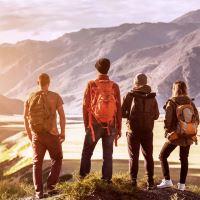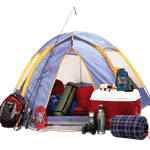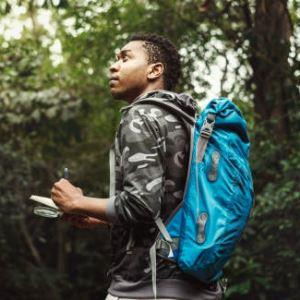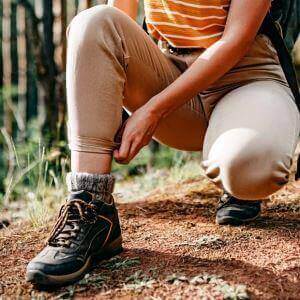 Climbing Mount Kenya is a rewarding adventure, offering dramatic landscapes and a genuine sense of achievement. As Africa’s second-highest peak, it often flies under the radar compared to Kilimanjaro, but many seasoned trekkers say it’s the more scenic and varied of the two. For UK hikers, planning this journey means looking beyond just the climb it’s about preparing for altitude, different climates, and the logistics of international travel. One of the first things to consider is timing. The best months to hike Mount Kenya are from January to March and July to October. These are the driest periods and offer the best chance for clear skies. Most hikers aim for Point Lenana, the third-highest peak and the only one accessible without technical climbing. It's a serious altitude at 4,985 metres, so acclimatisation and fitness are key. Getting there from the UK typically involves an 11 to 14-hour flight to Nairobi, with one stop along the way. From Nairobi, it’s about a 3- to 4-hour drive to the park gates. UK passport holders must apply for an eVisa before travel, which is a straightforward process online. It’s also important to check health requirements. Vaccinations for yellow fever, hepatitis A, and typhoid are often recommended, and there’s a malaria risk in lower areas, so preventive medication and insect repellent are advised. When it comes to gear, UK hikers should be ready for a mix of weather. You’ll need layered clothing, a warm sleeping bag, and waterproofs. Trekking poles, a headlamp, and sun protection are also essential. It’s smart to train before you go think hill walking with a loaded pack, building up cardio fitness, and preparing for several consecutive days on the trail. Some hikers even use altitude training masks or spend time in high-altitude areas in the UK or Europe. Choosing a route is another major decision. The Sirimon-Chogoria traverse is a popular option, offering a mix of forest, moorland, and alpine terrain over 5 to 6 days. Most UK visitors opt to go with a guide. While solo trekking is allowed in theory, park rules often require at least hiring a local guide or porter, and guided trips can ease altitude concerns and help with logistics. With good planning, climbing Mount Kenya can be an unforgettable adventure. It combines physical challenge with natural beauty and cultural discovery, making it one of East Africa’s top trekking experiences.
Climbing Mount Kenya is a rewarding adventure, offering dramatic landscapes and a genuine sense of achievement. As Africa’s second-highest peak, it often flies under the radar compared to Kilimanjaro, but many seasoned trekkers say it’s the more scenic and varied of the two. For UK hikers, planning this journey means looking beyond just the climb it’s about preparing for altitude, different climates, and the logistics of international travel. One of the first things to consider is timing. The best months to hike Mount Kenya are from January to March and July to October. These are the driest periods and offer the best chance for clear skies. Most hikers aim for Point Lenana, the third-highest peak and the only one accessible without technical climbing. It's a serious altitude at 4,985 metres, so acclimatisation and fitness are key. Getting there from the UK typically involves an 11 to 14-hour flight to Nairobi, with one stop along the way. From Nairobi, it’s about a 3- to 4-hour drive to the park gates. UK passport holders must apply for an eVisa before travel, which is a straightforward process online. It’s also important to check health requirements. Vaccinations for yellow fever, hepatitis A, and typhoid are often recommended, and there’s a malaria risk in lower areas, so preventive medication and insect repellent are advised. When it comes to gear, UK hikers should be ready for a mix of weather. You’ll need layered clothing, a warm sleeping bag, and waterproofs. Trekking poles, a headlamp, and sun protection are also essential. It’s smart to train before you go think hill walking with a loaded pack, building up cardio fitness, and preparing for several consecutive days on the trail. Some hikers even use altitude training masks or spend time in high-altitude areas in the UK or Europe. Choosing a route is another major decision. The Sirimon-Chogoria traverse is a popular option, offering a mix of forest, moorland, and alpine terrain over 5 to 6 days. Most UK visitors opt to go with a guide. While solo trekking is allowed in theory, park rules often require at least hiring a local guide or porter, and guided trips can ease altitude concerns and help with logistics. With good planning, climbing Mount Kenya can be an unforgettable adventure. It combines physical challenge with natural beauty and cultural discovery, making it one of East Africa’s top trekking experiences.
Key Facts for UK Hikers Planning to Climb Mount Kenya
| Topic | Details |
|---|---|
| Highest point | Point Lenana (4,985 metres) |
| Best season to hike | January to March, July to October |
| Visa requirement for UK citizens | eVisa required (apply online) |
| Recommended route | Sirimon-Chogoria traverse |
| Days needed for trek | 5 to 6 days |
| Altitude sickness risk | Moderate to high |
| Required vaccinations | Yellow fever, typhoid, hepatitis A, tetanus |
| Malaria risk | Yes, in lower elevations |
| Travel time from UK | Approx. 11-14 hours (1 stop) |
How to Prepare for Mount Kenya: A UK Climber’s Guide
Preparing to climb Mount Kenya from the UK takes more than just fitness it involves careful planning, the right gear, and understanding the conditions you'll face. Unlike local hill walks, this is a multi-day trek at altitude in a completely different climate, and being ready for that is key to enjoying the experience. Start by making sure you have the correct clothing. Temperatures vary widely on the mountain, with warm days and very cold nights. A layering system works best think moisture-wicking base layers, insulating mid-layers, and waterproof outerwear. A high-quality, four-season sleeping bag is essential, as is a sturdy pair of broken-in hiking boots. Other must-haves include trekking poles, a headlamp, gloves, sunblock, and a refillable water bottle with purification tablets or filter. Fitness and altitude are major considerations. Mount Kenya's Point Lenana sits at 4,985 metres, high enough to cause altitude sickness in unprepared climbers. It’s smart to begin regular hill walking and cardio workouts months in advance. Some UK hikers also use altitude simulation gear or take short trips to high-altitude locations in Europe to help their bodies adapt. This can go a long way toward making the climb more comfortable and safer. Health precautions shouldn’t be overlooked either. Before your trip, visit your GP or a travel clinic to get advice on vaccinations yellow fever, hepatitis A, typhoid, and tetanus are commonly recommended. There’s a risk of malaria in the lower regions of Kenya, so it’s also a good idea to bring insect repellent and speak to a doctor about antimalarial options. Another important step in how to prepare for climbing Mount Kenya from the UK is managing logistics like travel and permits. Flights from the UK to Nairobi are straightforward, often with just one layover. From there, you’ll drive to the base of the mountain. UK citizens need to apply for an eVisa before arrival. Be sure your passport has at least six months’ validity. Decide whether to hire a guide. Park rules may require you to take a guide even if you're experienced, and guided treks often include porters and cooks, which makes the trip more manageable. Many hikers find the local knowledge and logistical help well worth the cost. With solid planning and realistic expectations, climbing Mount Kenya can be a trip you’ll never forget.
What Gear to Pack for Mount Kenya Trekking from the UK
Packing the right gear is key to a successful and comfortable trek up Mount Kenya. Unlike a casual walk in the Lake District, this is a high-altitude, multi-day hike in variable weather. UK hikers need to plan smart and pack efficiently. Here’s what to focus on:
- Layered clothing for shifting temperatures: The weather on Mount Kenya changes quickly. Bring moisture-wicking base layers, insulating mid-layers like fleece or down, and a waterproof outer shell. Don’t forget thermal leggings and a warm hat for cold mornings and nights.
- Sturdy, broken-in hiking boots: This isn’t the time for new footwear. Your boots should be waterproof, ankle-high, and well broken-in. Consider gaiters to keep mud and small rocks out, especially during wet conditions.
- Four-season sleeping bag: Temperatures can drop below freezing at higher camps. A good sleeping bag rated for at least -5°C is a must. Pair it with an insulated sleeping mat for extra comfort and warmth.
- Trekking poles and headlamp: Poles help with balance and reduce the strain on knees during steep descents. A headlamp is essential for early starts or if you arrive at camp after dark bring spare batteries, too.
- Water purification and hydration system: Access to clean water isn’t guaranteed. Pack water purification tablets or a filter. A 2-litre hydration bladder or large water bottles will help you stay hydrated on the move.
- Sun protection and personal essentials: The equatorial sun is intense at altitude. Bring high SPF sunscreen, lip balm, sunglasses, and a wide-brimmed hat. Also pack blister plasters, basic first aid supplies, toilet paper, and quick-dry towels.
Getting your kit right helps you focus on the experience not on being cold, wet, or uncomfortable. It's worth laying everything out well before your flight to avoid last-minute stress.
Altitude Training Tips for UK Hikers Climbing Mount Kenya
Altitude can make or break your Mount Kenya experience, especially for hikers coming from sea level. Point Lenana, the most commonly trekked peak, rises to nearly 5,000 metres, making it essential to prepare your body well in advance. Start by understanding how altitude affects your body. As you climb higher, oxygen levels drop, which can lead to altitude sickness. Symptoms include headaches, nausea, and fatigue. To avoid this, UK hikers should begin training at least two to three months before departure. Hill walking is one of the most effective ways to prepare. Try to do regular hikes with a weighted backpack. The Peak District, Snowdonia, or the Scottish Highlands can offer decent elevation to help simulate the exertion you’ll feel on Mount Kenya. If you're based in a flatter part of the UK, consider using stair machines, treadmills set to incline, or multi-day hikes on hilly trails. Cardiovascular fitness is just as important. Running, cycling, or interval training can improve your heart and lung capacity, helping you better handle the thinner air at altitude. Try to include at least three cardio sessions per week in your routine. For those looking to go a step further, altitude simulation gear like masks or tents can help replicate high-altitude conditions. While not necessary for everyone, they may benefit those with a history of struggling at elevation. One final and essential piece of advice is to build rest days into your itinerary. Don’t rush the ascent. Give your body time to adapt by taking it slow and staying hydrated. Listen to your body and don’t hesitate to turn back if symptoms worsen. If you’re wondering about the best approach overall, this boils down to consistency and gradual buildup. These Mount Kenya hiking tips for British travelers will not only help improve your performance on the mountain but also reduce the risk of illness and make the whole trip much more enjoyable.
Reliable Guidance to Hiking Mount Kenya from the UK
 Planning a hike up Mount Kenya from the UK is both exciting and demanding. The mountain offers a rich mix of scenery, culture, and challenge, making it a standout trek and hike for British tourists looking to explore beyond Europe. But to enjoy it fully, it helps to understand the mountain’s terrain, how to manage altitude, and how to organise the trip from start to finish. The most recommended route for UK hikers is the Sirimon-Chogoria traverse. It offers diverse landscapes including bamboo forests, moorlands, and dramatic alpine sections. Most hikers take between five and six days to complete the trek. The slower pace allows for proper acclimatisation, which is crucial for avoiding altitude sickness. For many, one of the first decisions is whether to hire a guide or go independently. While some experienced hikers might feel confident on their own, it’s worth noting that Mount Kenya National Park regulations often require trekkers to take a guide or at least a porter. A guided trek removes much of the stress around logistics and safety, and local guides often share insight that adds to the experience. Flights from the UK to Kenya typically involve one stop and take between 11 to 14 hours. Once you land in Nairobi, expect a three to four-hour drive to the park gate, depending on your route. UK citizens need an eVisa to enter Kenya, and it’s best to apply online well ahead of travel. Make sure your passport has at least six months' validity left. Health prep is another key part of the process. Before travelling, check with your GP about recommended vaccinations such as yellow fever, typhoid, hepatitis A, and tetanus. Malaria risk is present in lower elevations, so anti-malarial medication and insect repellent are also advised. Fitness should not be overlooked either. While Mount Kenya doesn’t require technical climbing skills to reach Point Lenana, the altitude and daily hiking demand solid physical conditioning. In the months leading up to your trip, regular hill walks, cardio sessions, and carrying a loaded daypack will help. What UK hikers need to know about Mount Kenya is that it’s a trek that rewards those who prepare. It’s not just about the climb it’s about navigating travel logistics, staying healthy, and being ready for a real mountain environment. With proper planning, it’s a memorable adventure that offers far more than just a summit.
Planning a hike up Mount Kenya from the UK is both exciting and demanding. The mountain offers a rich mix of scenery, culture, and challenge, making it a standout trek and hike for British tourists looking to explore beyond Europe. But to enjoy it fully, it helps to understand the mountain’s terrain, how to manage altitude, and how to organise the trip from start to finish. The most recommended route for UK hikers is the Sirimon-Chogoria traverse. It offers diverse landscapes including bamboo forests, moorlands, and dramatic alpine sections. Most hikers take between five and six days to complete the trek. The slower pace allows for proper acclimatisation, which is crucial for avoiding altitude sickness. For many, one of the first decisions is whether to hire a guide or go independently. While some experienced hikers might feel confident on their own, it’s worth noting that Mount Kenya National Park regulations often require trekkers to take a guide or at least a porter. A guided trek removes much of the stress around logistics and safety, and local guides often share insight that adds to the experience. Flights from the UK to Kenya typically involve one stop and take between 11 to 14 hours. Once you land in Nairobi, expect a three to four-hour drive to the park gate, depending on your route. UK citizens need an eVisa to enter Kenya, and it’s best to apply online well ahead of travel. Make sure your passport has at least six months' validity left. Health prep is another key part of the process. Before travelling, check with your GP about recommended vaccinations such as yellow fever, typhoid, hepatitis A, and tetanus. Malaria risk is present in lower elevations, so anti-malarial medication and insect repellent are also advised. Fitness should not be overlooked either. While Mount Kenya doesn’t require technical climbing skills to reach Point Lenana, the altitude and daily hiking demand solid physical conditioning. In the months leading up to your trip, regular hill walks, cardio sessions, and carrying a loaded daypack will help. What UK hikers need to know about Mount Kenya is that it’s a trek that rewards those who prepare. It’s not just about the climb it’s about navigating travel logistics, staying healthy, and being ready for a real mountain environment. With proper planning, it’s a memorable adventure that offers far more than just a summit.
Best Routes on Mount Kenya for UK Hikers with Limited Time
If you're coming from the UK and only have limited time, choosing the right route on Mount Kenya is essential for making the most of your trip. The mountain offers several established trekking paths, each with unique scenery and different levels of challenge. Here are the key options to consider:
- Sirimon Route: This is one of the most popular routes, known for its gradual ascent and well-maintained paths. It’s ideal for acclimatisation and starts on the dry side of the mountain. The route takes you through forest and moorland with excellent views of the peaks. It usually takes three to four days to reach Point Lenana and descend.
- Chogoria Route: This path is often used for descent in combination with the Sirimon route. It passes through dramatic gorges, waterfalls, and beautiful alpine lakes. The landscapes here are especially varied and scenic. While steeper and more demanding, it’s well worth the extra effort for those who want to experience a broader range of the mountain’s terrain.
- Naro Moru Route: This is the shortest and most direct route to Point Lenana but also the steepest and most challenging. It’s best for fit hikers with prior altitude experience. One section, known as the "Vertical Bog," can be particularly tough in wet conditions.
- Burguret and Timau Routes: These are less commonly used and offer a more remote experience. However, they lack the facilities and support of the more popular trails, so they’re better suited for experienced trekkers.
The best time for UK hikers to climb Mount Kenya is during the dry seasons from January to March and July to October. These windows offer more stable weather and clearer skies, making for safer and more enjoyable mountain hiking. Most British hikers opt for the Sirimon-Chogoria combination over 5 to 6 days. It provides a great mix of terrain, manageable elevation gain, and enough time for acclimatisation. Whatever route you choose, plan according to your fitness level, schedule, and interest in scenery versus challenge.
Booking a guided trek or going solo: pros and cons
When it comes to climbing Mount Kenya, one of the key choices UK hikers need to make is whether to book a guided trek or go solo. Each option has its own pros and cons, and the right choice depends on your experience, comfort level, and how much planning you’re prepared to handle. Guided treks are the most popular option, especially for first-timers. These packages often include transport from Nairobi, park fees, meals, equipment, porters, and experienced local guides who know the mountain well. This makes the experience more relaxed and safer, particularly when dealing with altitude or route navigation. Guides also provide cultural insight and can adjust the pace to match your abilities. For many, this support is well worth the extra cost. On the other hand, going solo offers more flexibility and can be cheaper if you’re highly self-sufficient. However, it requires more effort in terms of research, booking transport, securing permits, and planning routes. You’ll also need to carry more gear or hire porters independently. National park regulations sometimes require solo hikers to at least hire a registered guide or ranger, so check the rules before assuming complete independence is possible. From a safety perspective, trekking with a guide is a safer bet. Altitude sickness is a real concern, and having a trained guide nearby can make a big difference. They’re experienced in spotting symptoms early and adjusting the plan accordingly. This is especially important if you haven’t done many high-altitude treks before or if you're still figuring out how to train for Mount Kenya from the UK. If you value ease, safety, and local expertise, guided treks are a solid choice. These trips offer structure, support, and a safety net, particularly valuable for first-time high-altitude hikers. Guides not only manage logistics but also provide insight into the landscape and local culture, making your journey more meaningful. On the other hand, if you’re confident in your navigation, fitness, and planning skills, and are happy to take full control of the trek, a semi-independent or solo approach may work for you. This style offers more flexibility in pace and itinerary, and can be more cost-effective, especially if you're already comfortable traveling in remote environments. However, it requires more preparation, especially in researching routes, permits, and transport. It’s also essential to understand that national park rules often mandate hiring a guide or porter, even for solo hikers. Be honest about your limits and experience level, and always double-check the latest park regulations before deciding which approach fits you best.






